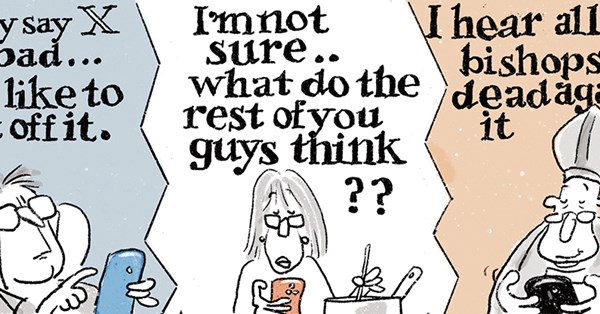THE decision by several dioceses and bishops to leave X (formerly Twitter) has sparked a debate (News, 17 January). Some, such as the Bishop of Barking, the Rt Revd Lynne Cullens, contend that the Church should remain present in challenging spaces, offering a Christian critique and countering the platform’s increasingly negative trajectory.
This perspective has merit. Christians are called to bring light into darkness and hope to the margins, engaging where others might retreat. Yet, as the realities of X grow harder to ignore, we must ask: is the Church’s voice still meaningful here, or is it time to leave a platform that actively undermines constructive engagement?
To understand the dilemma, it helps to reflect on X’s evolution. Founded in 2006 as Twitter, the platform was initially designed for short-form text communication. It introduced a new way of broadcasting thoughts in 140 characters, creating a global communication tool.
By 2013, Twitter had more than 240 million active users, establishing itself as a digital town square where conversations about politics, culture, and global events unfolded in real time. For individuals and institutions alike, it replaced traditional communication methods, enabling them to bypass mainstream media and reach vast audiences directly. The media also adopted it as a source of unfiltered opinion, often from high-profile figures, broadening their coverage.
This shift was evident during moments such as the deaths of Queen Elizabeth II and Prince Philip, both announced first on Twitter. More recently, the Archbishop of Canterbury’s resignation was also shared on the platform. By the 2020s, however, Twitter’s growth had already plateaued. While it peaked at 368 million monthly users globally, younger audiences increasingly gravitated towards platforms such as Instagram and TikTok.
AT THE heart of many discussions about social media is the term “algorithm”. This alludes to systems that determine what content users see, prioritising posts that evoke strong reactions such as outrage, shock, or debate, because this keeps users engaged. Platforms such as Twitter, which became advertisement-driven in 2010, rely on sustained user engagement to maximise revenue. This business model means that content that sparks polarisation is often prioritised. It fosters a cycle in which inflammatory posts gain prominence over thoughtful dialogue.
Twitter’s decline did not happen overnight. Its flaws, exposed during Donald Trump’s first presidency, exposed how its algorithms prioritised outrage over connection, often at the expense of truth. Even before Elon Musk’s acquisition of Twitter, it was criticised for using algorithms to amplify misinformation during elections and major events.
Under Mr Musk’s leadership, these problems have intensified, and doubt have grown about the platform’s ability to foster meaningful discourse. This erosion of trust has led many to conclude that using X no longer aligns with the Church’s values. It is not merely about enduring unpleasant interactions or stepping away from debates: it is about rejecting a system designed to distort constructive dialogue. For an institution and a gospel centred on truth, compassion, and charity, this creates a fundamental conflict.
While individuals — including some bishops and members of the Church’s elected bodies — may be drawn by the attention and influence that X’s chaotic environment can offer, the Church, as an organisation, together with its leadership, must carefully weigh the long-term risks of remaining aligned with a platform that amplifies divisive content at the expense of meaningful connection. But, beneath this, the fundamental question exists whether Christian mission can flourish in such a space.
FOR many, both within and beyond the Church, this decision is less about retreat than about recalibration. For the dioceses and bishops leaving X, it is about prioritising platforms where the message of Christ can be shared clearly and authentically, not by turning away, but by illuminating a better way forward.
Alternatives such as Facebook, Instagram, and Bluesky offer environments in which meaningful engagement seems more achievable, but they are not without their own challenges. Facebook, for instance, has also been criticised for its algorithmic manipulation and promotion of divisive content, though it lacks X’s extreme toxicity. Bluesky, with its decentralised framework and emphasis on giving users more control over their data, looks promising, but it remains in its early stages and will need monitoring. A shift in leadership or ownership could compromise its values, especially if profit or influence overtook its founding ideals.
This issue will not be the last of its kind. As digital platforms evolve, supercharged by AI, the Church will face recurring ethical challenges in navigating these spaces while staying true to its values. Such decisions may require sacrificing hard-built audiences and the potential to reach thousands. But this is, surely, a price worth paying if the Church is to reject synthetic polarisation and algorithm-driven content designed to maximise profit rather than the public good.
For now, the evidence suggests that stepping away from X may well be the right move, and that the Church must focus on platforms where genuine dialogue can exist if it is to remain a credible and compassionate force for good in the evolving digital landscape.
The writer, whose identity is known to the Church Times, works in communications.
This article was originally published by a www.churchtimes.co.uk . Read the Original article here. .

